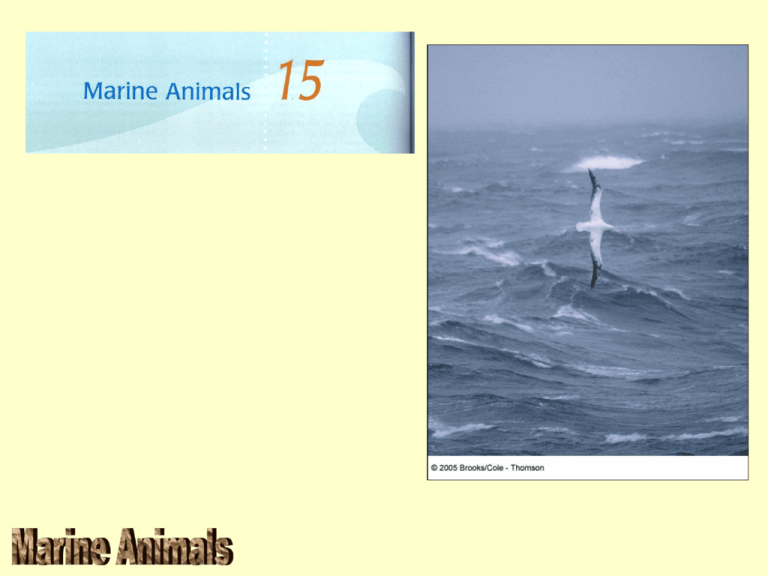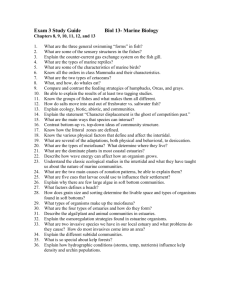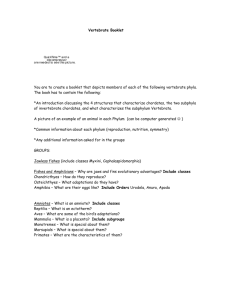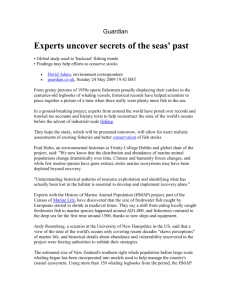Crustaceans dominate the world of marine animals!
advertisement

Adaptations to their environment help define animals.. A Tuna consumes as much as 25% of its body weight in food each day. That’s like a 150 lb person eating 38 lbs of food each day.. Tunas burn so much energy they tend to “overheat”, so water temperature is important to them. Tunas must swim continuously, else they would suffocate and/or sink to the bottom. They swim from California to Japan and back, sometimes going 15 – 20 miles per day. They can go as fast as 68 miles per hour for short times. A group of animals that share similar “architecture”, level of complexity, and evolutionary history is called a phylum. (from “phylon” = tribe!) Invertebrates – generally soft-bodied animals lacking a rigid internal skeleton for the attachment of muscles, but many with a hard, protective outer covering which can be continuous ( shell) or segmented ( a lobster shell). There are at least 33 invertebrate phyla, and they range in size from microscopic worms to giant squids Phylum Porifera Over 10,000 species, ranging in size from a bean to a small automobile! They are “filter feeders” straining water through them to obtain suspended nutrients and plankton. A sponge may strain 400 gallons of water each day! Sponges have no digestive systems, nor do they have a circulatory system, respiratory system, or nervous system! Diffusion takes care of it all… Porifera structure Phylum Cnidaria (Coelenterata) Jellyfish, Sea Anemones, and Corals. These animals use stinging cells to immobilize their prey – usually zooplankton and small fish.They move the victim to a saclike digestive cavity where the digested nutrients are moved by migratory cells to other parts of the body. There is only one opening to the digestive cavity, so indigestible materials must be eliminated through the mouth….(yuk) A “Sea Wasp” is the most dangerous jellyfish in the world. It inhabits tropical waters from Africa to northeastern Australia, and can kill a human within 3 minutes! The tentacles of a large specimen can reach 50 feet long. Corals are also classified as cnidarians. They are solitary animals with bodies up to 12 inches in diameter, but most of the more than 500 species are ant-sized organisms crowded into colonies. Corals feed at night, and retract into their shells to escape sunlight and predators. The structure of Coral Worms….. • Are significantly more “advanced” than cnidarians • Exhibit bilateral symmetry (left and right, not radial) • Have some concentrations of sensory systems in their “heads” • Have a “flow through” digestive and excretory system • Some are parasites, but most are free-living More information Click picture for website An intertidal marine flatworm – the thin body allows gases, nutrients and waste to diffuse in and out! Amphitrite, a tubeworm; Eunice, an active swimming predator; Serpula, which lives in stony tubes and grasps prey as it moves by The Polychaeta are the largest and most diverse class of marine annelids. The “feather duster” is a food/breathing device. Advanced Invertebrates - Phylum Mollusca The Mollusks are “softbodied” animals with over 80.000 species. It contains such diverse members as clams, snails, octopuses, and squid. Most mollusks are marine, and most have an internal or external shell. They may share common ancestry with annelids. Mollusca - Gastropods (the snails) Members of this class usually inhabit relatively large shells, where they can seek refuge. Some gastropods are grazers, some as suspension feeders, and some are predators. The “foot” of a snail will not “attach” it to ocean sediments. Their shells are usually considered to be beautiful and complex. Gill structure A nudibranch is a gastropod without a shell. They have a terrible taste which seems to discourage predators! Mollusca – the Bivalves (clams, oysters, mussels) These filter feeders strain large volumes of water through their gills. They traded mobility for protection Mollusca – Cephalopods (squids, nautiluses, octopuses) The most highly evolved mollusks are the Cephalopods. They have a head surrounded by a foot divided into tentacles. They move by creeping across the bottom, by swimming with special fins, or by squirting jets of water. 250 pounds! Phylum Arthropedia – lobsters, shrimp, crabs, krill, and barnacles These animals have been very successful, in spite of the fact they have not developed the complex nervous systems of cephalopods, nor do they have great intelligence or great eyesight (like squids!). Their bodies are a variation of annelids – bilaterally symmetric with a pair of appendages per segment. What they do have are: • An exoskeleton – strong, lightweight, form-fitted (chitin) • Striated muscle – quick, strong lightweight • Articulation – they can bend their appendages Generalized arthropod and vertebrate growth curves – the exoskeleton must be shed each time for the arthropod to grow. This is a time of particular vulnerability for the organism. Largest class of arthropods – the insecta – is poorly represented in the sea. (5 species of “water striders”) The class crustacea has over 30,000 primarily marine species. Their bodies usually have between 16 – 20 segments, with specialized appendages. About 70% of all zooplankton are crustaceans. Crustaceans dominate the world of marine animals! A molting crab! Phylum Echinodermata The exclusively marine phylum Echinodermata has about 6,000 species. They lack eyes or brains, but have developed a number of adaptations which have made them successful. They have a body based on 5-sided symmetry. The 5-sided jaw of a sea urchin Web site for more info! Five classes of Echinoderms. Four most common are: • Asteroidea – the sea stars • Ophiuroidea – the brittle stars • Echinoidea – the sea urchins and sand dollars • Holothuroidea – the sea cucumbers Starfish have a water-vascular system which can be used to open the shells of a clam or mussel. Ophiuroids have long, slender arms which they can “break off” (and eventually regenerate) if this will help them escape. They are perhaps the most widely distributed benthic (bottom-dwelling) marine animals Echinoids are very familiar to most coastal residents. Sand Dollars and Sea Urchins are examples. Holothuroids are the well-named “sea cucumbers” . Most of them feed by thrusting small, sticky appendages into the surrounding sediments, retracting the appendages, and eating the goodies on them… Sea cucumbers have a seemingly suicidal defense mechanism -- when annoyed, these animals pressurize themselves and eviscerate violently, forcefully ejecting their digestive systems, respiratory apparatus, and sexual glands. The water around them churns with sticky, mucus-coated innards which tend to damage the gills and esophagus of the predator which was trying the eat the cucumber. Unless it is a human… It regenerates completely in 2-3 weeks… A Sea Cucumber –an animal, not a salad! Chordata – the most advanced animal phylum. This “chord” or backbone provides a framework for the internal development and structure of the organism. About 5% of the 45,000 species of chordates subsequently lose this chordate and are called invertebrate chordates; but the other 95% keep it! These 95% make up the familiar vertebrate chordates such as fishes, reptiles, birds and mammals! Two Invertebrate Chordates of interest are the tunicate (sea squirt!) and the amphious. Tunicates – you are related to these guys…! The Amphioxus is seen as a link between invertebrates and vertebrates due to its notochord and dorsal tubular nervous system Vertebrate Evolution and Classification Least successful in marine environment Most successful in marine environment Class Agnatha - Hagfishes and Lampreys are jawless fishes which also have no paired fins to help in locomotion and stabilization. Their round, sucking mouths are surrounded by organs sensitive to touch and smell. Their eyes are degenerate – useless – and covered by thick skin. Their body ends in a tail that undulates to provide propulsion. They prefer feeding on the soft, inner flesh or internal organs of other organisms, and they use their tongue to “drill” their way in. There are only about 50 species of these. They make great pets…. The Charming Hagfish… pictures and a Lamprey Class Chondrichthyes – includes sharks, rays, skates and chimaeras. These have been successful for at least 250 million years (twice as long as dinosaurs!) , and they appear not to have changed much in this time. All members of this class have a skeleton made of cartilage – true bone is entirely absent from this group. They have fins, jaws and teeth… Neither sharks nor rays have swim bladders, and will slowly sink if they stop moving. A Manta Ray – it eats plankton, not divers! Sharks! 80% of sharks are less than 6 feet long, and only a few of the remaining 20% are aggressive to humans. Great Whites are the most dangerous to people. They can be as big as 23 feet and weigh up to 3,000 pounds. The largest shark is the Whale Shark. It can be up to 60 feet long and weigh 90,000 pounds. They eat plankton! Class Osteichthyes – the bony fishes! 27,000+ species are the most numerous of all vertebrates on the planet! Their numbers include the air-breathing lungfishes whose ancient relatives broke from the path of evolution to establish the land vertebrates. Fish exhibit many advanced characteristics: • Swim bladders for neutral buoyancy • Independently movable fins for well-controlled swimming • Great speed • Social organization (schooling) • Migration patterns The diversity of bony fishes… It’s tough being a fish.. • Water is about 1000 times as dense as air – it impedes motion • Vertical position must always be maintained with minimum energy expenditure • Exchange of CO2 and O2 is more complex in a higher density material • Osmotic balance, especially in changing salinities • 3-dimensional range for predators Movement, shape and propulsion Eel-like fishes which use their entire body length for swimming are less efficient than more advanced fishes which use a “hingedtail” type of motion. Advanced fishes Vertical position • Density of fish tissue is slightly greater than water, so fish will sink unless their mass is offset by propulsive forces or buoyant gas- or fat-filled bladders. • Sharks (and other cartilaginous fishes) must swim to maintain their position – they generate lift like an airplane does! • Swift-swimming fish like tuna and marlin do not have a swim bladder, because the rapid, high speed depth changes they experience while chasing prey (or trying to avoid becoming it) would rupture the bladder as pressure changed. Gas Exchange An active fish like a Mackerel requires so much oxygen and produces so much CO2 that its gill surface area must be ten times its body surface area. Fish extract about 85% of the dissolved oxygen flowing past their gills (while air breathing vertebrates extract only about 25%!) Osmoregulation in freshwater and marine fishes Feeding and Defense Passive cryptic coloration – the fish looks like a seaweed blade! Active cryptic coloration in a turbot. Some fish avoid predators by disappearing completely from the marine environment! Amphibians (frogs, salamanders & toads) Only about 2000 living species exist, and none are exclusively marine (although some large SE Asian frogs can tolerate salinity up to 28 ppt for extended periods of time. Sea Turtles – • may weigh up to 1300 lbs • Navigate over incredibly long distances to the beach where they were originally hatched • Humans are the only predators! Hey, dude… Marine Crocodiles Only one living species of true marine crocodile – they can reach 23 feet long and weigh over a ton. They live in Australia and Indonesia. Their Louisiana and Florida cousins live in brackish or fresh water and are much smaller and less dangerous. Sea Snakes Probably the most evolutionary advanced of the marine reptiles. There are 50 species, mostly in SE Asia and the Indian Ocean. None live in the Atlantic. With one exception, they give birth to live young and never come onto land. All of them are venomous, and their venom is among the most powerful anywhere! Marine Birds Birds (class Aves) probably evolved from small, fast running dinosaurs about 160 million years ago. Their reptilian heritage is clearly evident in their scaly legs and claws, and in the arrangement of their internal organs and skeletons. There are 8,600 living species of birds. They are endotherms – warm blooded. They have light, thin hollow bones, and have forsaken heavy teeth and jaws for a lightweight beak. Only about 3% of birds are “sea birds”, and most of these live in the southern hemisphere. True sea birds avoid land except for breeding, and obtain all of their food from the sea. The Tubenoses The Albatross can have a wingspan of 12 feet and a mass of 22 lbs. Their wing structure allows very efficient flight, and they typically travel up to 9,300 miles on foraging trips. They see and smell fish, and catch them by dipping their bill into the water during flight. Pelicans and their Relatives Order Pelecaniformes - All of these birds have throat pouches and webbed feet. They don’t spend as much time over the open sea as their tubenose relatives. Their wings are adapted to slow flight. The class includes pelicans, cormorants, frigate birds, and boobies) Penguins Penguins have completely lost the ability to fly, but they use their reduced wings to swim for long distances and with great maneuverability. Their “grounded” status makes weight unimportant, so they have fatty insulation and neutral buoyancy. They are native to only the southern hemisphere and range in size from a duck to more than 3.3 feet. Emperor Penguins Mammals Class Mammalia is the most advanced vertebrate group. There are about 4,300 species, including humans! Three groups are: Cetacea – porpoises, dolphins and whales Carnivora – seals, sea lions, walruses and sea aotters Sirenia – manatees and dugongs Marine Mammal Adaptations • Streamlined body shape with limbs adapted for swimming • They generate internal body heat – large body size favors smaller surface area to volume ratio (remember cells with larger surface area to volume ratio…?) • Lungs and respiratory system adapted to collect and retain large quantities of oxygen • They meet their water needs with the metabolic water derived from the oxidation of food Some representatives from the order Cetacea (these are all baleen whales that feed on krill) Toothed whales! Echolocation, used by toothed whales to locate and perhaps stun their prey Baleen plates A surfacing Blue Whale with a throat full of water and food. California Sea Lion Harbor Seals Sea Otters frequently live in or near kelp beds. They have the densest fur of any mammal! Polar Bears – an arctic only marine carnivore And they don’t drink Pepsi…







